| THIS WEEK'S ARTICLES |
| John Murphy's Market Message |
| STOCKS SELL OFF ON JOBS REPORT |
| by John Murphy |
STOCK INDEXES GAP LOWER... Stocks are selling off sharply following this morning's September job report which came in a bit stronger than expected. That may be a case of good economic news being bad for stocks because it keeps the Fed on its path of higher interest rates. The daily bars in Chart 1 show the Dow Industrials gapping lower today. The red boxed area shows three trading days surrounded by Tuesday's up gap followed by today's down gap. That leaves a small "island reversal" which is a bearish pattern. Today's selling also keeps the Dow below its June low which was broken last week. Chart 2 shows a similar negative pattern in the S&P 500.
NASDAQ THREATENING JUNE LOW... The tech-dominated Nasdaq market is leading the market lower today. Chart 3 also shows the Nasdaq Composite Index bearing down on its June low. Technical odds favor that previous low being broken. Technology is the day's weakest sector probably owing to another jump in interest rates. Consumer Discretionary stocks are also showing relative weakness. Energy remains the only sector in the black today along with another strong day for crude oil. This week's OPEC decision to lower crude oil production starting next month has boosted energy prices and stocks tied to them. Rising energy prices are also inflationary which is probably contributing to higher bond yields. All in all, that represents a negative combination for stocks.
 Chart 1 Chart 1
 Chart 2 Chart 2
 Chart 3 Chart 3
|
| READ ONLINE → |
|
|
|
| The Canadian Technician |
| Why This Rollover is So Important |
| by Greg Schnell |
Monday started with a bounce. We were off to the races. After closing on the lows on Friday, we quickly bounced higher. It feels so good when the market rips to the upside. Thursday saw the market work lower and Friday took the wind out of the sails again.

If we make this into a line chart, we have some clear levels that are important. They become more obvious when we open up the chart to include the June low. 371 was a support level in late June that we held above. As we came down and tested the prior low, the market spent a week trying to go lower, and was working hard as it flipped back and forth. This week, we surged back above the 371 level, but could not hold it. Friday is closing near the June low again. Now, it looks more likely that we will need to test a lower level for the market to find buyers.
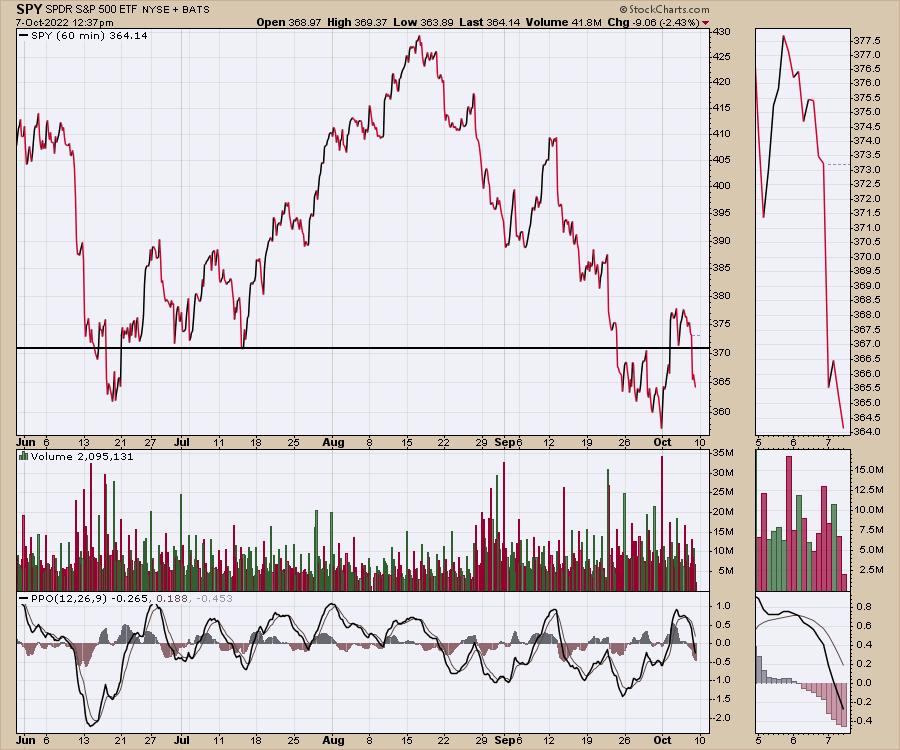
The fact that it took a week to hold those lows, and the rally couldn't hold for a few days, doesn't bode well for price action next week either.
As we expand out to the weekly chart, a few things are becoming more apparent. The black line is where the market topped out before COVID, and now that level looks more likely to be tested.
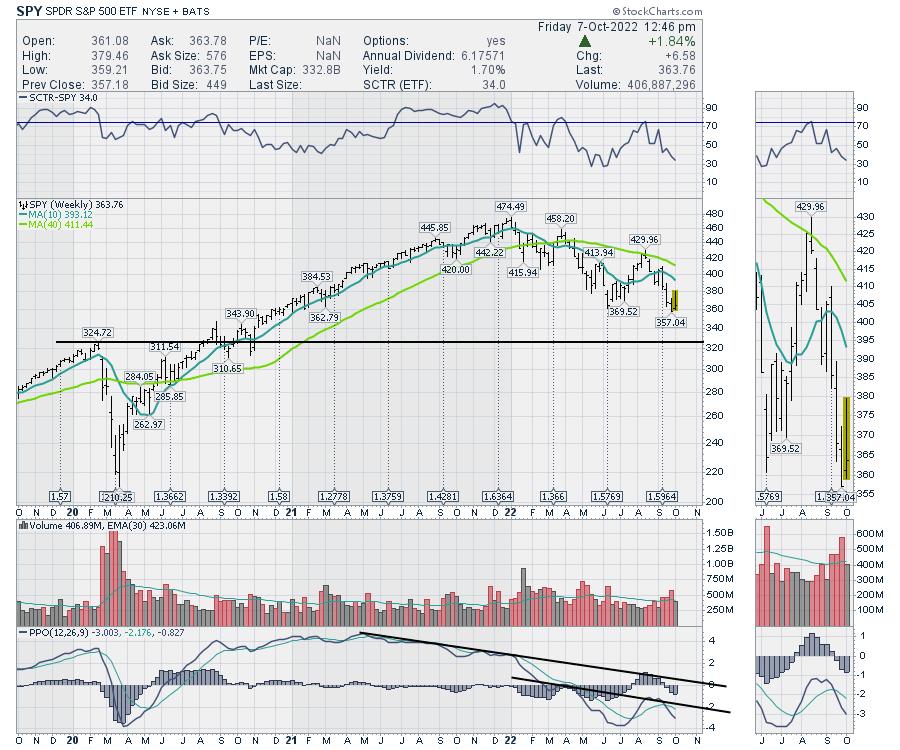
I have drawn two lines on the PPO. One is a shorter-term trend line from the March highs. The longer trend line goes back to May of 2021. That trend line is still a larger force, that is not being tested at all. The price action this week started to look like we could turn the PPO up here and at least break the short-term down trend in October.
Friday's price action makes the breaking of that short term trend line less likely in the near future. As long as the trend in momentum remains down, it is very difficult to expect the market to go higher. These sudden spurts that roll over quickly weaken the trend in both directions;, but the bottom line is that we are trending down in price and momentum on all time frames.
Lots of seasonality charts talk about October as a good month to expect a bottom. But the volatile price action at these lows makes it very difficult to have and to hold many positions in either directions. There are better times to be invested, and the price action this week confirms that.
|
| READ ONLINE → |
|
|
|
| Martin Pring's Market Roundup |
| The Oil Price Gets Resuscitated: Is it Enough to Keep the Bull Market Alive? |
| by Martin Pring |
Just when it seemed that oil was peaking, OPEC breathed new life into the commodity this week by threatening a sizeable production cut. That does not change the overextended nature of the longer-term indicators. Nevertheless, it does hint that oil prices and their related stocks may be on the verge of another up leg.
Long-Term Charts
Chart 1 sets the longer-term theme, as it tells us that the West Texas Intermediate recently experienced a false upside breakout. That move was then confirmed by a negative 12-month MA crossover. Normally, a whipsaw such as this is followed by an above-average move in the opposite direction to the breakout. However, prices are determined by people's emotions. Since people can and do occasionally change their minds, it follows that markets can also. In the current situation that may mean the oil market is in the process of re-grouping as a prelude to moving higher. I don't think the odds favor such a scenario, but it's important to bear in mind that it stands a sporting chance of happening.
The signal most likely to achieve that change would be a credible month end close above the multi-year resistance trendline and the 12-month MA -- let's say, a nice round $100.
 Chart 1 Chart 1
Chart 2 is much stronger, as it shows the SPDR Energy ETF (XLE) to be well above its breakout trendline and 12-month MA. The shares, unlike the commodity, never triggered a sell signal. Since the XLE discounts the future average price of oil, this is a very bullish sign. Does it mean that oil prices are guaranteed to move higher? Absolutely not! However, if you are trying to build a bullish case, it is nicer to have the shares on your side than not.
 Chart 2 Chart 2
Short-Term Charts
Chart 3 indicates that the oil price is in a short-term downtrend. However, it is now at resistance in the form of the 10-week MA and June/October down trendline. This positioning offers the possibility that the price may be in the early stages of forming the right shoulder of a large head-and-shoulders top. That is highly speculative, currently, but worth monitoring for a future possible development in the event that the current rally fizzles out.
 Chart 3 Chart 3
Returning to Wednesday's picture, we see that the daily KST has just triggered a buy signal. Note that it has also diverged positively with the price itself. Divergences are only potential until confirmed. In this case, that would involve a breaking of the 2022 down trendline and 10-week MA.
Chart 4 shows the shorter-term action for the US Oil Fund, the USO, where the crucial state of the technical position is even more apparent. Note that the price is right at the two converging trendlines, as well as the 10- and 200-day moving averages. That's happening at the same time the KST is crossing above its signal line and is setting up a positive divergence with the price. If those two converging trendlines are violated, it would indicate a head-and-shoulders failure, thereby suggesting a strong move to the upside.
 Chart 4 Chart 4
The XLE is again featured in Chart 5, where we can see that it recently experienced a false downside breakout below its 2021-2022 up trendline and 200-day MA. This move has been partially confirmed by a tentative violation above the post June down trendline. However, the real test lies at the red-dashed line, representing the most recent rally peak at $83. The upside reversal in the KST suggests that this resistance will be overcome.
 Chart 5 Chart 5
Finally, the US Gasoline Fund (UGA) did complete a head-and-shoulders top. Adding to the credibility of the break was the fact that it was accompanied by a negative 200-day MA crossover. However, that break is now questionable because things have reversed in the last few days, as the price is now back above both the neckline and both moving averages. It has also crossed above its post-June down trendline, thereby confirming the positive divergence between it and the daily KST.
 Chart 6 Chart 6
Conclusion
The long-term picture for the oil price, as painted in Chart 1, is bearish. The shorter-term charts also broke down but are now fighting back and are at resistance. If they can push through it, the ensuing rally will probably have enough power to reverse the longer-term charts as well. How far the price might rally is unknown. What is known is the death of the oil bull market would have been greatly exaggerated.
Good luck and good charting,
Martin J. Pring
The views expressed in this article are those of the author and do not necessarily reflect the position or opinion of Pring Turner Capital Group of Walnut Creek or its affiliates.
|
| READ ONLINE → |
|
|
|
|
|
| Top Advisors Corner |
| COT Report Data Work Backwards in Bitcoin |
| by Tom McClellan |
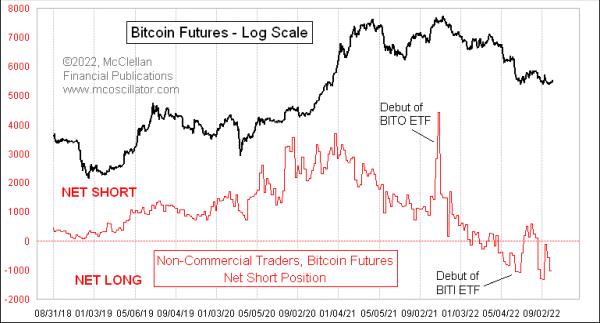
The data that the CFTC publishes in its weekly Commitment of Traders (COT) Report tell us about the positioning of the different types of traders that they track. That can provide useful sentiment indications for a variety of futures markets, if interpreted correctly. This week, I look at how the COT data on Bitcoin futures go against how things normally work.
The "commercial" traders are the ones who use the subject commodity in their trade or business. Usually, they are the smart money. The "non-commercial" traders are the large speculators -- think hedge funds. And the "non-reportable" traders are ones whose positions are so small that the CFTC figures they are not worth bothering to track individually.
As mentioned, in most futures contracts, it is the commercial traders who are the "smart money." But in Bitcoin, things work differently. There, it is the large speculators who are the smart money, most of the time. The COT Report data on Bitcoin futures only go back to 2018, so there is not a lot of history on this topic.
The chart above shows that the non-commercials' net position as a group is positively correlated with the Bitcoin price action. And when they get to a big skewed position, that tends to matter as a sentiment reading for Bitcoin prices. These traders have been net long since earlier this summer, evidently expecting a bounce to come for Bitcoin prices.
It is a rather fascinating, but not surprising, historical oddity that Bitcoin prices peaked with the debut of the BITO ETF, which allows you to hold a Bitcoin proxy in your brokerage account. And the week that the inverse ETF BITI was opened for trading marked the bottom.
By contrast to the large speculators, the commercial traders' net position in Bitcoin futures is inversely correlated with Bitcoin prices. The normally smart money crowd seems to be quite horrible at knowing what prices are going to do.

During some of the history of the COT data, there have been periods when there were zero contracts held by the commercials. We do not know what the characterizations that the CFTC has chosen to make about the commercial traders of Bitcoin futures are, but we can say that these traders do not seem to be very prescient about what Bitcoin prices are going to do.
There is a new product just out for those wanting to play with Bitcoin futures. The Micro Bitcoin futures contract is worth 1/10 the amount of the big one, and it has been rapidly gaining a following among traders. And, as with the big Bitcoin contract, it appears that it is the non-commercial traders who are the smart money, although that was arguably not the case in the first few weeks of its trading back in mid-2021.

The bottom chart shows the net position of those non-commercial traders in the Micro contract, and what I find noteworthy is the rapid move toward an even bigger net long position that they have been undertaking in the past 8 weeks, and that is with Bitcoin prices mostly going sideways during that time. So one cannot say that this position change is price-induced; they are moving further to the long side based on no price action. Evidently they know something, or think that they do. History suggests that this will be a bullish development for Bitcoin prices, eventually.
|
| READ ONLINE → |
|
|
|
| Mish's Market Minute |
| The Battle of Supply and Demand, Oil, Gold and the Market |
| by Mish Schneider |
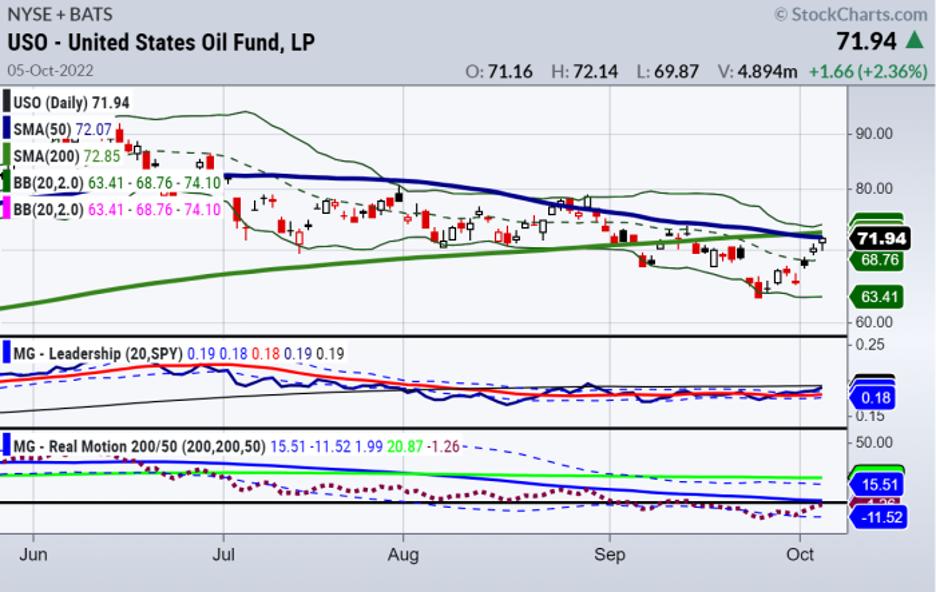
As predicted, and as we wrote about yesterday, oil prices continued to climb in anticipation of an OPEC+ production cut. Reports confirmed today that OPEC+ will cut production by 2 million barrels a day.
The Strategic Petroleum Reserve (SPR), which the Biden administration has tapped to ease gas prices, has dropped to its lowest level since 1984, and scheduled releases will end soon. The continuation of multiple Russian sanctions and the decrease in supply should exert upward pressure on oil prices.
Will the stock market rally this week and be able to shrug off rising oil prices? What do higher energy prices mean for global inflation?
The global energy demand and supply imbalance will take time to resolve and, long-term, more resources must be put towards renewable, nuclear and alternative fuels. On the demand side, the critical element of the European gas plan going into the winter of 2022-2023 is reducing consumption, which is, regrettably, not yet happening. Although some people are optimistic, the reality is that inflation will remain problematic if the European energy crisis and the conflict in Ukraine continue. OPEC+'s production cut has the potential to increase global inflation unintentionally.
The United States Oil ETF (USO) increased on Wednesday to 71.94, which is barely below both its 50-day moving average and 200-day moving average. USO has strong leadership, good momentum and a divergence in Real Motion, all of which indicate higher prices ahead.
Mish writes a mid-week column for CMC Markets and, in her article today, she explains that we are looking for the end of inflation in "all the wrong places." She covers the Supercycle in commodities and how stagflation is impacting global markets. Mish addresses historical correlations from 1972, 1982 and other pivotal years; her analysis addresses many areas of the commodity cycle, particularly the gold price, gold miners, and the S&P 500. She points out that several commodities tend to start a positive trend shortly after gold starts to outperform the S&P 500.
In this period of historically high inflation, investors are wise to keep an eye on the oil and gold markets.
Is MarketGauge right for you? You can sign up for a free consultation with Rob Quinn, our Chief Strategy Consultant, by clicking here. He'll help you learn more about Mish's top-rated risk management trading service.
Mish's Upcoming Seminars
ChartCon 2022: October 7-8th, Seattle (FULLY VIRTUAL EVENT). Join me and 16 other elite market experts for live trading rooms, fireside chats, and panel discussions. Learn more here.
- October 7th 11:15 AM (ET), 8:15 AM (PT) Stock Picking Lightning Round with Mish
- October 8th 2:00 PM (ET), 11:00 AM (PT) Bulls vs. Bears Debate with Keith and Mish on opposing sides of a trade!
The Money Show: Join me and many wonderful speakers at the Money Show in Orlando, beginning October 30th running thru November 1st; spend Halloween with us!
Trader's Summit: Mish speaks with Helene Meisler on October 23rd at 12pm ET. Learn more here.
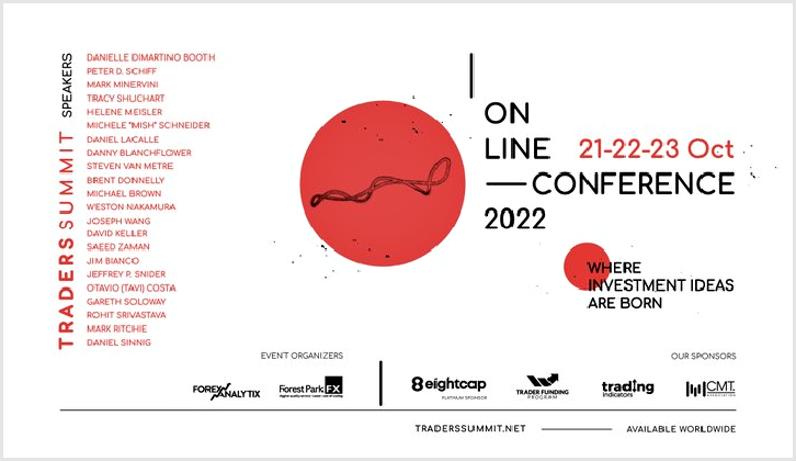
 "I grew my money tree and so can you!" - Mish SchneiderGet your copy of Plant Your Money Tree: A Guide to Growing Your Wealth and a special bonus here. "I grew my money tree and so can you!" - Mish SchneiderGet your copy of Plant Your Money Tree: A Guide to Growing Your Wealth and a special bonus here.
Follow Mish on Twitter @marketminute for stock picks and more. Follow Mish on Instagram (mishschneider) for daily morning videos. To see updated media clips, click here.
Mish in the Media
Read Mish's latest article for CMC Markets, titled "Are We Due Another Supercycle in Miners and Precious Metals?".
Mish talks hedges and stock picks under the current environment in this appearance on BNN Bloomberg.
Mish says yes to Palantir, no to Bed, Bath and Beyond in this appearance on CNBC Asia.
Mish talks about a few of her picks, going short and why metals are in focus in this appearance on TD Ameritrade.
Mish talks putting your cash to work in this appearance on Business First AM.
Mish and Neil Cavuto discuss Central Bank credibility, US policy and more inflation to come on Fox Business's Coast to Coast. Unless this is a spectacular bottom, preserving cash is smart.
Mish talks about key averages, yields and commodities on this appearance on Bloomberg TV.
ETF Summary
- S&P 500 (SPY): 375 support, 379 resistance.
- Russell 2000 (IWM): 172.30 support, 176.57 resistance.
- Dow (DIA): 298 support, 305 resistance.
- Nasdaq (QQQ): 277 support, 283 resistance.
- KRE (Regional Banks): 60.30 support, 64.77 resistance.
- SMH (Semiconductors): 197 support, 210 resistance.
- IYT (Transportation): 203 support, 211 resistance.
- IBB (Biotechnology): 119.32 support, 124.25 resistance.
- XRT (Retail): 58.70 support, 62.75 resistance.
Mish Schneider
MarketGauge.com
Director of Trading Research and Education
Wade Dawson
MarketGauge.com
Portfolio Manager
|
| READ ONLINE → |
|
|
|
| MORE ARTICLES → |
|
 Chart 1
Chart 1 Chart 2
Chart 2 Chart 3
Chart 3



































